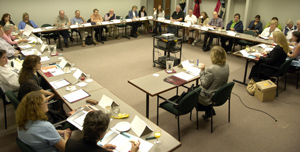|
||
      |
Open house with Hamlet
“Oh, that this too too sullied flesh would melt / Thaw, and resolve itself into a dew!” First the Laurence Olivier scene played on the projector screen; then Anne, a brave woman in the would-be class, read the soliloquy aloud. Halfway through the Graham School’s Basic Program open house, 30 attendees were analyzing Hamlet, Prince of Denmark in a Gleacher Center basement classroom.

Roundtable discussion: about 30 people showed up for the Basic Program
open house.
“Notice the allusions to famed characters: Hercules, Niobe,” said Elisabeth Lenckos, the Basic Program instructor leading the sample class. “The texts all speak to one another.” She asked what Hamlet’s frame of mind seems to be as he gives the play’s first monologue. “Angry,” answered Bob, wearing a blue vest. “Suicidal,” said Nancy. “Yes, suicidal,” Lenckos, in black-rimmed glasses, jumped back in. “He wishes that his flesh would melt.”
The group, ranging from 30- to 60-somethings, went on to discuss the despicable act Hamlet’s mother had committed, language revealing his feelings of impurity and weakness, and how Shakespeare used flesh to represent sin and death.
Lenckos prodded the group about the line, “...’Tis an unweeded garden / That grows to seed...” Shakespeare was a Renaissance writer, she noted, when “nice, orderly gardens” were preferred. This one, she said, “means disaster.” The garden represented both Hamlet’s family and Denmark, where “the failure of morality in one person—the king—will contaminate everything: the garden, the state, the world.”
Before the sample class, as Basic Program chair Clare Pearson, AB’82, AM’01, detailed the 60-year-old curriculum, the group had trouble imagining a typical course. “Did I hear you right that there’s no lecture during the class?” asked blue-vest Bob. “Then what’s the instructional part?” Pearson had tried explaining Socratic-discussion style already but attempted once more. The instructors, she said, almost all Chicago-educated, “can clarify things, ask questions to draw out the texts. It is instructor as facilitator. The discussion is really a two-way process.”
The Basic Program, she said, grew out of the Hutchins/Adler book group. Although “technically around” before 1946, that was the year it took the Basic Program name. Originally for credit and meeting two days a week, it’s now no-credit and meets one day a week. “By the time people graduate from the program,” Pearson said, “it’s amazing how people will make references that everyone in the room gets.”
To wit, she asked the attendees to pull out the Basic Program Quarterly from the red informational folders at each seat and turn to the four-year reading list, which has remained “amazingly constant.” Focused on “great works of Western civilization,” the list begins with Sophocles, Plato, and Dostoevsky and ends with Aristotle, Smith, Marx, Euclid, Lincoln, Burke, Tocqueville, Xenophon, and still more Plato. Sprinklings of the Bible, Homer, Twain, Joyce, Darwin, Freud, and several others show up in between.
Each course is divided into two portions, Pearson explained: a seminar covering several readings, and a tutorial, where the class reads a shorter work together in class and then digs deep into it. “The Meno tutorial in the fall surprises people at first,” she said. “Only 35 pages in 11 weeks.” Yet each time she’s taught the course she’s felt “a rush to finish. Those 35 pages are rich. It was the first work given to students in Plato’s academy,” directing them “how to learn, how to investigate philosophy. It’s a challenge, but by the end you know how to read a Platonic dialog, which is a unique thing.”
Several hands rose. “How much reading time should we count on per week?” asked another Bob in a blue windbreaker. Answer: at least five or six hours to “get something out of the program.” Marge, with curly red hair, asked if over the four years students would be exposed to a variety of instructors. Answer: yes. In fact, Pearson said, “we don’t encourage people to follow certain instructors.”
Soon she turned the floor over to Lanckos, who dimmed the lights and let Hamlet himself demonstrate.